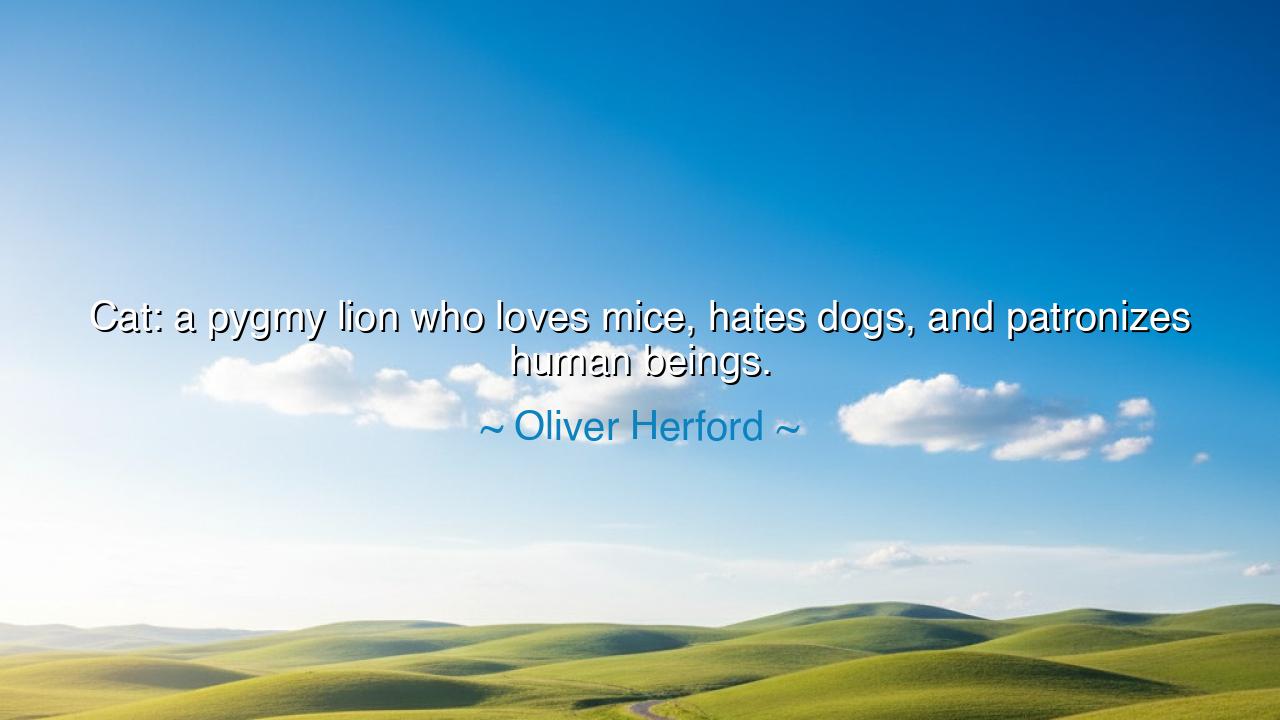
Cat: a pygmy lion who loves mice, hates dogs, and patronizes






Hear the words of Oliver Herford, who with wit and sharp observation declared: “Cat: a pygmy lion who loves mice, hates dogs, and patronizes human beings.” Though wrapped in humor, these words carry truth as enduring as stone. They are not merely about the animal itself, but about the mystery of power in smallness, the paradox of love and disdain, and the strange kinship between beasts and mankind.
For what is the cat but a shadow of the lion, the king of beasts made small and domestic? In its graceful stride, in its piercing gaze, in its sudden fury, we see the echo of the jungle sovereign. Though shrunken in size, its spirit is no less fierce. Thus Herford calls it a pygmy lion—a reminder that greatness of spirit does not always match the stature of the body. The might of the cat lies not in its bulk, but in its independence, its mystery, its unbending pride.
And yet, this pygmy lion is bound by curious contradictions. It “loves mice,” for in the chase it finds delight, not merely hunger. The hunt is its sport, its art, its passion. It “hates dogs,” for the dog is servile, eager to please, noisy in its loyalty—everything the cat is not. And as for men, the cat does not serve but rather patronizes them, as though it were the master and we the humble attendants. In this we glimpse a deeper truth: the cat teaches us that affection without subservience, and love without surrender, are possible even within bonds of companionship.
The ancients knew the duality of the cat. In Egypt, cats were worshiped as divine, embodiments of Bastet, goddess of protection and home. To harm a cat was to risk death, for they were guardians against both plague and evil spirits. Yet in medieval Europe, cats were feared, seen as companions of witches, despised for their aloofness and their nocturnal wandering. Loved and hated, revered and reviled, the cat has always carried the aura of the mystical, the untamed, the half-divine.
Herford’s playful description is also a mirror held up to mankind itself. For are we not too like the cat—small against the cosmos, yet proud as kings? Do we not chase trifles as if they were great prey? Do we not harbor disdain for some, affection for others, and superiority toward those who serve us? The cat becomes not only an animal but an allegory of human pride and paradox: creatures both mighty and fragile, both affectionate and dismissive, both tame and wild.
Thus the teaching emerges: in the cat we are reminded that dignity is not bound to size, that independence has its own majesty, and that true companionship does not always mean obedience. The cat shows us that love may coexist with pride, and that affection need not bow to servility. From it, we learn that the spirit, not the stature, defines the nobility of a being.
The lesson for us is this: carry yourself with quiet pride, like the pygmy lion. Do not measure greatness in size or in noise, but in presence, in poise, in the unshakable dignity of being true to yourself. Love what you love with passion, disdain what you must with honesty, but never surrender the essence of your spirit to the demands of others. For just as the cat walks beside us yet remains untamed, so too should we walk in the world: companions to many, servants to none, kings within the small kingdoms of our own souls.
So let your action be this: honor your independence, cultivate your dignity, and embrace the paradox within you. Be like the cat—fierce though small, affectionate though aloof, free even in the midst of companionship. For in such a way, you shall live not as a servant of the world’s whims, but as a sovereign of your own spirit.






AAdministratorAdministrator
Welcome, honored guests. Please leave a comment, we will respond soon